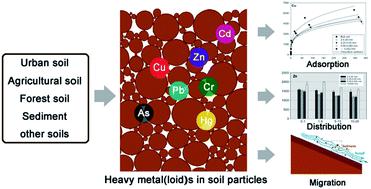当前位置:
X-MOL 学术
›
Environ. Sci.: Processes Impacts
›
论文详情
Our official English website, www.x-mol.net, welcomes your feedback! (Note: you will need to create a separate account there.)
Effects of soil particle size on the adsorption, distribution, and migration behaviors of heavy metal(loid)s in soil: a review.
Environmental Science: Processes & Impacts ( IF 5.5 ) Pub Date : 2020-06-24 , DOI: 10.1039/d0em00189a Bin Huang 1 , Zaijian Yuan 2 , Dingqiang Li 1 , Mingguo Zheng 2 , Xiaodong Nie 3 , Yishan Liao 2
Environmental Science: Processes & Impacts ( IF 5.5 ) Pub Date : 2020-06-24 , DOI: 10.1039/d0em00189a Bin Huang 1 , Zaijian Yuan 2 , Dingqiang Li 1 , Mingguo Zheng 2 , Xiaodong Nie 3 , Yishan Liao 2
Affiliation

|
In recent years, toxic pollution from heavy metal(loid)s in soil has become a severe environmental problem worldwide. The migration and transformation of heavy metal(loid)s in soil have become hot topics in the field of environmental research. Soil particle size plays an important role in influencing the environmental behavior of heavy metal(loid)s in soil. This review collates and synthesizes the research on the adsorption, distribution, and migration of heavy metal(loid)s in soil particles. There is no unified method for soil particle separation, since the purposes of different studies are different. Regardless of adsorption or distribution characteristics, fine soil particles generally exhibit a higher capacity to combine heavy metal(loid)s; however, certain studies have also observed a contrary phenomenon, according to which heavy metal(loid)s were more enriched in coarser particles. The adsorption and distribution of heavy metal(loid)s in soil particles were essentially determined by the physicochemical properties of the soil particles. Land use obviously affected the distribution of heavy metal(loid)s in the soil particles. Organic matter had an important influence on the distribution and availability of heavy metal(loid)s in agricultural and forest soils, while for urban soils and sediments, clay minerals or metal (hydr)oxides may play the dominant role. Preferential surface migration of fine particles during erosion processes did not always lead to the enrichment of heavy metal(loid)s in the lost soil. Further research should be conducted to explore the relationships among the soil aggregates, organic matter, heavy metal(loid)s, and soil microorganisms; the association between the distribution and availability of heavy metal(loid)s and the properties of soil particles; and the migration patterns of heavy metal(loid)s in soil particles at different scales.
中文翻译:

土壤粒径对土壤中重金属(胶体)的吸附,分布和迁移行为的影响
近年来,土壤中重金属(金属)的有毒污染已成为世界范围内的严重环境问题。土壤中重金属(胶体)的迁移和转化已成为环境研究领域的热门话题。土壤粒径在影响土壤中重金属(胶体)的环境行为中起着重要作用。本文综述并综合了土壤颗粒中重金属(胶体)的吸附,分布和迁移研究。由于不同研究的目的不同,因此没有统一的土壤颗粒分离方法。不论吸附或分布特性如何,细小的土壤颗粒通常都具有较高的结合重金属(胶体)的能力。但是,某些研究也发现了相反的现象,根据哪个重金属(胶体)更富集于较粗的颗粒。重金属(胶体)在土壤颗粒中的吸附和分布主要取决于土壤颗粒的理化性质。土地利用显然影响了土壤颗粒中重金属(胶体)的分布。有机物对农业和森林土壤中重金属(胶体)的分布和有效性具有重要影响,而对于城市土壤和沉积物,粘土矿物质或金属(氢)氧化物可能起主要作用。在侵蚀过程中,细颗粒的优先表面迁移并不总是会导致流失土壤中重金属(胶体)的富集。应该进行进一步的研究以探索土壤团聚体,有机质,重金属(胶体),和土壤微生物;重金属(金属)的分布和有效性与土壤颗粒性质之间的联系;以及不同尺度下土壤中重金属(胶体)的迁移规律。
更新日期:2020-08-19
中文翻译:

土壤粒径对土壤中重金属(胶体)的吸附,分布和迁移行为的影响
近年来,土壤中重金属(金属)的有毒污染已成为世界范围内的严重环境问题。土壤中重金属(胶体)的迁移和转化已成为环境研究领域的热门话题。土壤粒径在影响土壤中重金属(胶体)的环境行为中起着重要作用。本文综述并综合了土壤颗粒中重金属(胶体)的吸附,分布和迁移研究。由于不同研究的目的不同,因此没有统一的土壤颗粒分离方法。不论吸附或分布特性如何,细小的土壤颗粒通常都具有较高的结合重金属(胶体)的能力。但是,某些研究也发现了相反的现象,根据哪个重金属(胶体)更富集于较粗的颗粒。重金属(胶体)在土壤颗粒中的吸附和分布主要取决于土壤颗粒的理化性质。土地利用显然影响了土壤颗粒中重金属(胶体)的分布。有机物对农业和森林土壤中重金属(胶体)的分布和有效性具有重要影响,而对于城市土壤和沉积物,粘土矿物质或金属(氢)氧化物可能起主要作用。在侵蚀过程中,细颗粒的优先表面迁移并不总是会导致流失土壤中重金属(胶体)的富集。应该进行进一步的研究以探索土壤团聚体,有机质,重金属(胶体),和土壤微生物;重金属(金属)的分布和有效性与土壤颗粒性质之间的联系;以及不同尺度下土壤中重金属(胶体)的迁移规律。



























 京公网安备 11010802027423号
京公网安备 11010802027423号